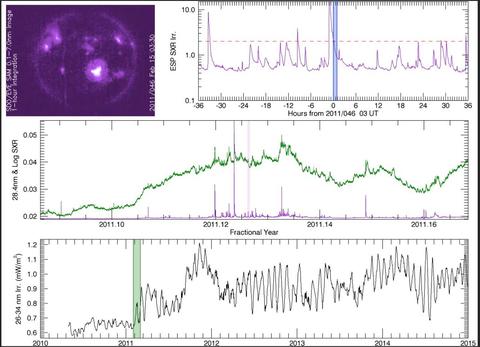Summary
NASA launched the Solar Dynamics Observatory (SDO) satellite on 11 Feb 2010 on a mission to study the sun. The EUV Variability Experiment (EVE) on SDO contains the Extreme Ultraviolet Spectrophotometer (ESP), an instrument to record the intensity of solar ultraviolet radiation over time in five wavelength bands. Information from ESP will be used learn about solar activity and to provide to near real-time predictions of space weather.
Description

The SDO satellite is the first mission in NASA's Living With a Star program, which aims to understand the connections between the Sun and Earth. In addition to the light and heat with which we are familiar, the Sun produces x-ray radiation, extreme ultraviolet light, and the solar wind which consists of both neutral and charged particles. Periodically, the Sun emits billions of tons of matter in coronal mass ejections. These violent events can cause magnetic storms in Earth's magnetosphere and upper atmosphere. Magnetic storms, in turn, affect many systems on which humans depend: the functioning and orbits of satellites (including communications and GPS) and electric power grids.
The Extreme Ultraviolet Spectrophotometer (ESP) instrument on SDO is designed to measure the solar output in five wavelengths bands in the extreme ultraviolet (EUV) spectral region. The instrument consists of a transmission grating and a set of detectors. The grating disperses the incident radiation and four detectors measure the EUV radiation in first-order diffraction at four wavelengths: 19 nm, 25 nm, 30 nm, and 36 nm. A fifth detector in the undispersed (zero-order) beam measures the EUV radiation over the entire wavelength band from 0.1 nm to 7.0 nm.
The ESP instrument on SDO was calibrated at SURF III at the EUV Detector Radiometry Beamline (BL-9) and then recalibrated on Spectrometer Calibration Beamline (BL-2) after integration with the EVE package. To calibrate ESP on BL-9, the instrument was mounted on a four-axis manipulator at the rear of the beamline and its response to incident EUV radiation was compared to a calibrated Si photodiode that was inserted into the beam upstream of the ESP entrance aperture.
Since the instrument on SDO can not be retrieved for recalibration, a nominally identical instrument is periodically flown on a sounding rocket and makes observations of the Sun simultaneously with the instrument on SDO. The rocket instrument is calibrated at BL-9 before and after each rocket flight, and the NIST calibration is transferred to the SDO instrument.

